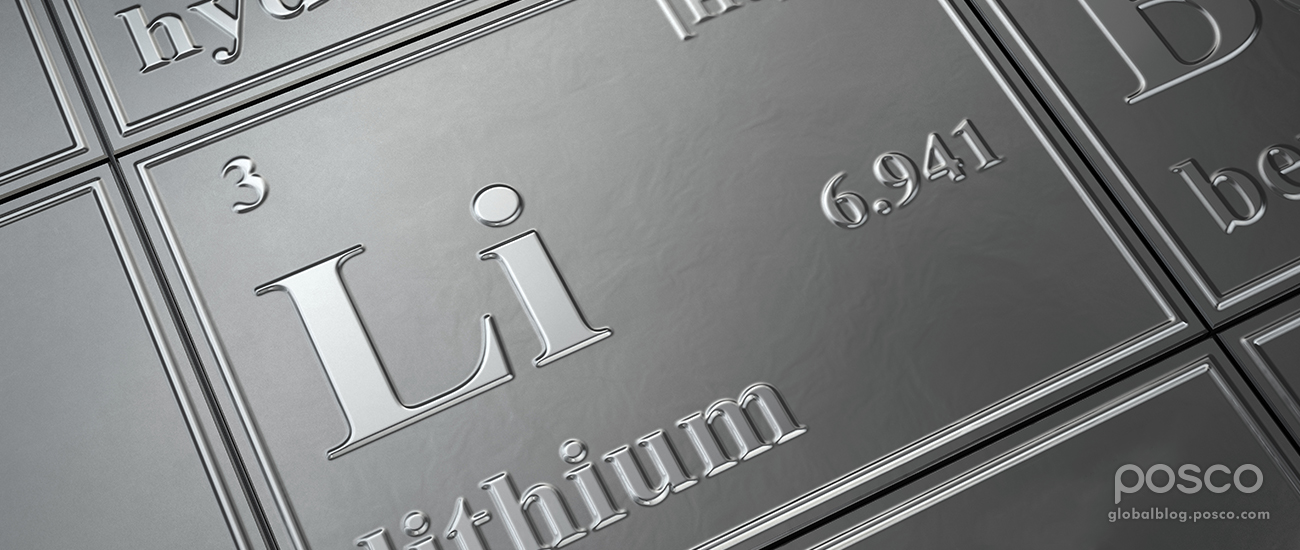Lithium is considered by many analysts to be the hottest commodity on the planet. Goldman Sachs called it the “new gasoline” and predicted demand for the soft alkaline element could triple by 2025. It is an important part of the latest rechargeable battery technology, offering more power to a wide range of devices, like mobile phone batteries and electric cars.
The use of lithium is soaring. It’s gone from 70,000 tons in 2002 to 170,000 tons in 2014, and some estimate that could grow to 470,000 tons by 2025. And with that surging demand, POSCO has identified lithium as a major product for the company’s future business growth.
“POSCO is accelerating the lithium material industry after lithium was selected as the new growth business that will lead the future of the company,” said CEO Ohjoon Kwon when he became the head of POSCO in 2014. “If steel is the ‘rice’ of the current industry, lithium will take on that role in the future.”
What Is Lithium?

For such a common element, most people don’t know a lot about lithium. The soft, silver-white metal is the third element on the periodic table, making it the lightest metal and least-dense solid element. It is found commonly around the Earth, but because it is highly reactive, it is rarely found in a pure, elemental form, and instead is present in very low concentrations in sea water, in rock in the Earth’s crust (especially granite), and in brines and salt lakes.
Importantly, lithium is also very energy-dense—in fact, it has twice the energy density of the next closest alternative—making it a great option for portable energy storage applications.
Lithium, however, is quite difficult to extract. In the past, it was gathered on large salt farms, and required months for the water to evaporate, leaving lithium salts behind. But in 2010, POSCO (with support from the Ministry of Trade, Industry and Energy) developed a high-efficiency technique for extracting lithium from water. Instead of a large and slow evaporation process, POSCO uses a chemical reaction to extract the lithium more quickly. It also increased its extraction capabilities to 200 tons per year.
 Now POSCO is expanding its lithium processing even more, opening a cutting-edge lithium processing plant at Pozuelos Salt Lake in Argentina this year. Built high in the Argentine mountains, some 4,000 meters above sea level, the new plant had a groundbreaking ceremony on February 14, and once operational later this year it will boost POSCO’s annual lithium production to 2,500 tons.
Now POSCO is expanding its lithium processing even more, opening a cutting-edge lithium processing plant at Pozuelos Salt Lake in Argentina this year. Built high in the Argentine mountains, some 4,000 meters above sea level, the new plant had a groundbreaking ceremony on February 14, and once operational later this year it will boost POSCO’s annual lithium production to 2,500 tons.
Lithium in IT Gadgets

Lithium is a key element in lithium-ion batteries, which power many of our most popular devices, including mobile phones and laptops. Lithium-ion batteries can generate a 3 volt charge in each cell, much more than lead-acid and zinc-carbon cells, meaning it can provide more power more efficiently.
For portable devices, like mobile phones, size and weight are at a premium, so being able to contain more power means being able to create smaller and more useful mobile gadgets. Lithium-ion batteries are also commonly used in portable power tools, like drills, saws and lawn trimmers.
In addition to the success of lithium-ion rechargeable batteries, regular lithium batteries are also in high demand, often used in such devices as pacemakers, cameras and watches.
Lithium for a Green Future
Beyond gadgets, lithium-ion batteries are a big part of the future of green energy. Solar, wind and other renewable energy sources are important, but you still need an energy storage device to store that power between peaks and valleys.
In particular, they are at the heart of the latest developments in electric cars, like the very popular Tesla cars. And as an electric car usually requires around 40 kilograms of lithium for its lithium-ion battery, that adds up quickly. In fact, Goldman Sachs estimates that the amount of lithium needed for electric car batteries will go up 11-fold over the next nine years.
But the eco-friendly applications don’t stop with cars. Motorcycles, large-scale residential facilities and industrial facilities are all increasingly using lithium-ion batteries, too.
POSCO Leads the Way Toward a Lithium Future
“With the supply of electric cars and the development of smart grid technology, the market is expected to result in massive growth,” noted CEO Kwon. “In order to raise competitiveness of the domestic secondary cell industry, it is crucial to develop lithium resources along with localizing core material.”
Pozuelos Lake, where POSCO is building its new processing facility, covers 106 square kilometers, and has an estimated 1.5 million tons of lithium reserves. That’s enough for millions of large-scale lithium-ion cells, which is good news for the environment and our planet.
